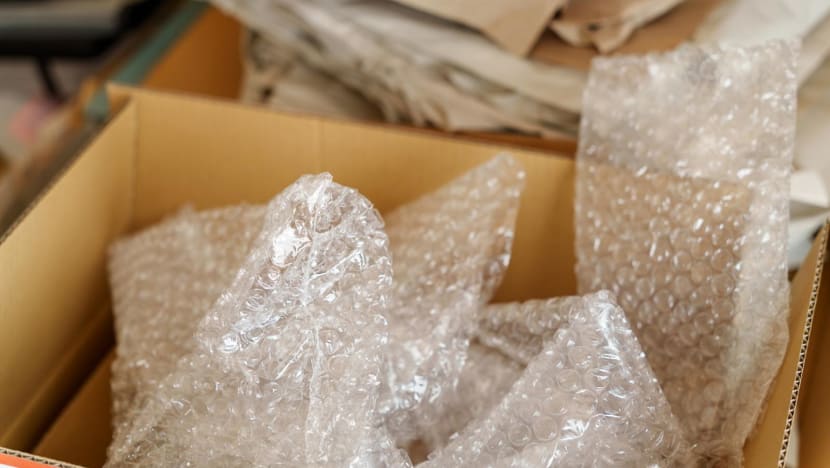New guidelines for e-commerce businesses to cut down on packaging waste
About 186,000 parcels were delivered in Singapore per day in 2023, generating as much as 15,900 tonnes of packaging in one year.

Singapore generated as much as 15,900 tonnes of mailing packaging in 2023 alone. (Photo: iStock/Wako Megumi)

This audio is generated by an AI tool.
SINGAPORE: A new set of guidelines was introduced on Tuesday (Mar 4) to help the e-commerce sector minimise its packaging waste, including seven specific ways to cut down on cardboard box usage.
The guidelines were developed by an Alliance for Action looking at packaging waste in e-commerce - 14 companies spanning e-commerce marketplaces, retailers and packaging producers, as well as industry experts. The alliance is co-led by the Singapore Manufacturing Federation (SMF) and Singapore Post, with support from the National Environment Agency (NEA).
An estimated 186,000 parcels were delivered in Singapore per day in 2023, generating as much as 15,900 tonnes of packaging that year alone – roughly equivalent to the weight of 1,200 double-decker buses.
The guidelines outline practical "3R" solutions – reduce, reuse and recycle – tailored to various packaging materials, including cardboard boxes, mailers and fillers.
For cardboard boxes alone, there were seven recommendations for businesses – from expanding the range of box sizes available to switching to lighter alternative packaging.
Each recommendation includes step-by-step actions, expected benefits and potential drawbacks. They are benchmarked against estimated effort, cost and environmental impact to allow businesses to adopt solutions that best fit their needs, the agencies said.
What are the new guidelines?
E-commerce businesses are given a list detailing conventional packaging types and the ways they can reduce the amount of packaging, reuse packaging or switch to alternative materials.
Corrugated cardboard boxes
- Ship products in their own packaging
- Switch to lighter alternative packaging
- Install an automated packing machine that makes boxes of the correct sizes
- Reassess cardboard box specifications and application
- Expand the range of cardboard sizes at the packing stations
- Use of custom-designed corrugated cardboard boxes for specific goods
- Use boxes with multiple crease lines for easy folding
- Repurpose old boxes from warehouses into fillers by cutting or shredding them
- Improve design to allow return of goods without additional packaging
- Use paper-based tape, seal or water-soluble glue instead of plastic tape
Cardboard trays
- Expand the range of tray sizes at packing stations
Carrier bags made of paper and plastic
- Expand the range of carrier bag sizes at the packing station
- Reduce the thickness of carrier bags
- Avoid using carrier bags made of multiple materials
- Avoid sealing carrier bags with incompatible materials
- Opt for alternative materials or designs such as bio-based plastics
Mailers made of paper and plastic
- Install an automated right-sizing packaging machine that can produce paper or plastic mailers of the correct size
- Expand the range of mailer sizes at the packaging station
- Reduce mailer thickness
- Design mailer bags to allow return of goods without extra packaging
- Source mono-material mailers
- Opt for alternatives such as bio-based materials
Insulated bags or pouches
- Expand the range of bag and pouch sizes at the packing stations
- Use alternatives such as paper-based insulated bags or boxes
Fillers and protective packaging
- Recover and reuse of material available in the warehouse or packing centre
- Optimise the weight of filler and protective packaging by using crumpled paper for instance
- Reassess the use of fillers and select the most resource efficient combination
- Choose alternative materials such as bio-based materials or styrofoam peanuts
Ice and gel packs
- Switch from gel packs to reusable frozen drinkable water bottles to maintain cold temperatures
- Instruct consumer about the possibility of recycling ice or gel packs
Insulated boxes
- Expand the range of box sizes at the packing station
- Choose alternatives such as cardboard boxes with separable insulation panels
Labels (plastic and paper-based)
- Print information directly on the packaging using inkjet printing or laser marking
- Reduce label dimensions
- Switch to linerless labels
- Match label material with packaging material for easier recycling
Initiatives for e-commerce marketplaces to promote sustainable packaging to consumers and drive awareness and responsibilities among suppliers are also outlined.
A recent study by WWF-Singapore found that consumers want more sustainable packaging, but with only a small minority willing to pay extra for environmentally friendly choices.
The guidelines also feature a scorecard tool for companies to assess their sustainability efforts and identify areas for improvement.
"Based on real-world case studies, companies may uncover opportunities to reduce packaging needs by up to 90 per cent, such as by switching from a corrugated cardboard box to a similar-sized paper mailer," NEA, SMF and SingPost said.
For instance, beauty and health retailer Watsons Singapore reduced bubble wrap usage and repurposed shredded cardboard as filler material, leading to cost savings of 5 to 10 per cent. Packaging company Sealed Air found that faster deliveries enabled apparel retailers to use less protective packaging, cutting plastic and paper mailer material by 30 to 50 per cent.
To encourage businesses to adopt these guidelines, workshops will be conducted under the Packaging Partnership Programme, launched in 2021 and administered by SMF.
Addressing packaging waste is a key goal under Singapore's Zero Waste Masterplan, which aims to increase the national recycling rate to 70 per cent by 2030.
"All stakeholders in the e-commerce ecosystem, including businesses and consumers, have an important role to play in managing packaging materials responsibly," said NEA, SMF and SingPost.
















